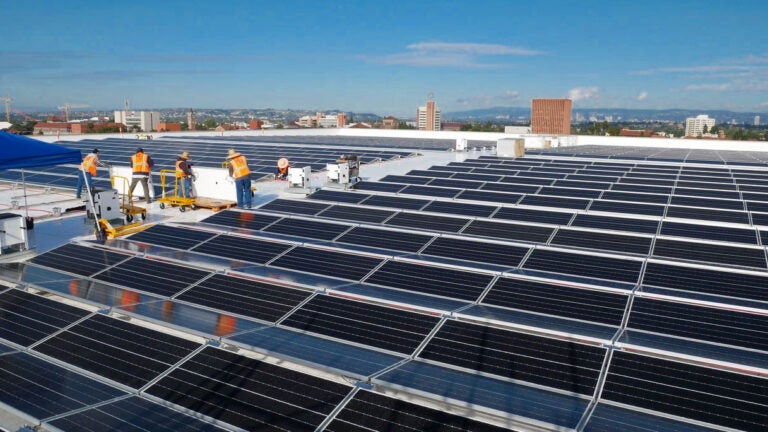
Solar panels on the roof of the Galen Center help USC reach its sustainability goals. (Photo/Zelinda Welch)
USC meets goal for greenhouse gas reductions
The achievement is the first time the university has set — and met — a target for carbon-based emissions.
USC reduced greenhouse gas emissions from its two chief sources by 35% in the past six years, university officials report.
The reduction from 2014 to 2020 marks an important milestone on the path to sustainability, exceeding the 20% goal the university had established in 2015. The achievement is also the first time USC has set — and met — a target for carbon-based emissions linked to planetary warming.
The decrease in emissions also demonstrates the university’s commitment to real and transparent environmental metrics, which will become more common in the months ahead.
The gains point the university toward its long-term goal of carbon neutrality, which will underpin the 2028 sustainability master plan that is forthcoming later this year.
The university benefited somewhat from changes outside its control. The coronavirus pandemic and ensuing lockdown clipped emissions slightly last year, while low-carbon renewable energy accounted for more of the electricity provided by the Los Angeles Department of Water and Power, USC’s main source of juice.
Nonetheless, a proliferation of campuswide energy conservation measures proved highly effective. For example, solar panels installed atop the Galen Center last year produce 915,000 kilowatt-hours of clean energy annually — enough to power 88 houses for a year. About 40% of USC student housing is now lit with LED fixtures. Widespread equipment retrofits, including new chillers at the USC Norris Comprehensive Cancer Center and Helen Topping Architecture and Fine Arts Library, also contributed. In all, these cost-effective measures accounted for about one-third of the greenhouse gas reductions; DWP efforts accounted for the rest.
“This is very good news,” said Zelinda Welch, energy manager for USC Facilities Planning and Management. “We improved energy efficiency on campus, we reduced use of fertilizers, we reduced refrigerant leaks, we cut water use and more.”
Despite more buildings and more vehicles, USC reduces greenhouse gases
The new data on emissions are part of a broad accounting of key environmental metrics underway for the first time at USC. The results were shared April 23 during the USC “Voices of Sustainability” webinar, during which President Carol L. Folt talked with students and university environmental leaders as part of Earth Day activities.
Six years ago, the university committed to a 20% reduction in directly emitted greenhouse gases. It was an ambitious goal at the time and marked the first concerted attempt by the university to reckon with its contribution to global warming. The goal was consistent with the United Nations’ Paris Agreement, which committed countries to deep cuts in carbon emissions and was adopted by 196 parties in 2015.
USC’s greenhouse gases come from various sources, including heating and cooling buildings, food preparation, chemicals and fertilizers, as well as travel-related activities. Some sources, like buildings and operations, are under the university’s direct control (16% of emissions); some, like electricity generation and consumption, are under partial university control (38%); and others the university has little control over, such as emissions caused by business travel or people visiting the campuses (46%).
USC emitted 304,355 metric tons (CO2 equivalent) annually of greenhouse gases in 2014; by 2020, the total was reduced to 245,407 tons — a 19.3% reduction.
But those numbers don’t tell the whole story. In fact, the university underwent a growth surge in the six-year tracking period, adding about 26% more building space as well as more faculty, staff and students and more vehicles and energy use, Welch explained. Recent additions include USC Village, the Michelson Hall for Convergent Bioscience and the USC Jimmy Iovine and Andre Young Academy. Adjusting for emissions per square foot, at both the University Park and Health Sciences campuses USC actually cut emissions from its operations, from 11 tons per square foot in 2014 to 7 tons in 2020 — a 35% reduction.
The pandemic contributed to some of the reductions, as many university buildings were closed the past year. However, that change occurred in but one of the six years of the reporting period and it was significantly offset by the fact that air circulation in some buildings had to increase to minimize potential for spread of the airborne virus. Moreover, the Zoom-managed, work-at-home regimen implemented in response to the pandemic has become so popular that it might continue, in part, after the university reopens later this year — an action that could help USC reduce emissions from commuter trips.
USC to release data on entire environmental footprint in fall 2021
Christopher Toomey, vice president and executive director of capital construction and facilities management and planning department, said investments in sustainability today make sense.
“The long-term, cost-effective actions we take today are truly a win-win for the university,” he said.
By fall semester, the USC Office of Sustainability will for the first time release comprehensive data on the university’s entire environmental footprint. The data are being assembled as part of the Sustainability Tracking, Assessment and Rating System, or STARS, which is managed by the Association for the Advancement of Sustainability in Higher Education. USC joined the program earlier this year.
STARS is the benchmark by which more than 1,000 American colleges and universities track and disclose progress toward green goals. It’s an important step for the university’s growing sustainability program because it commits USC to a standardized method to inventory all its environmental actions, set baselines and measure progress. All the data is publicly reported and ranked against peer institutions, potentially inspiring universities to outperform each other.



